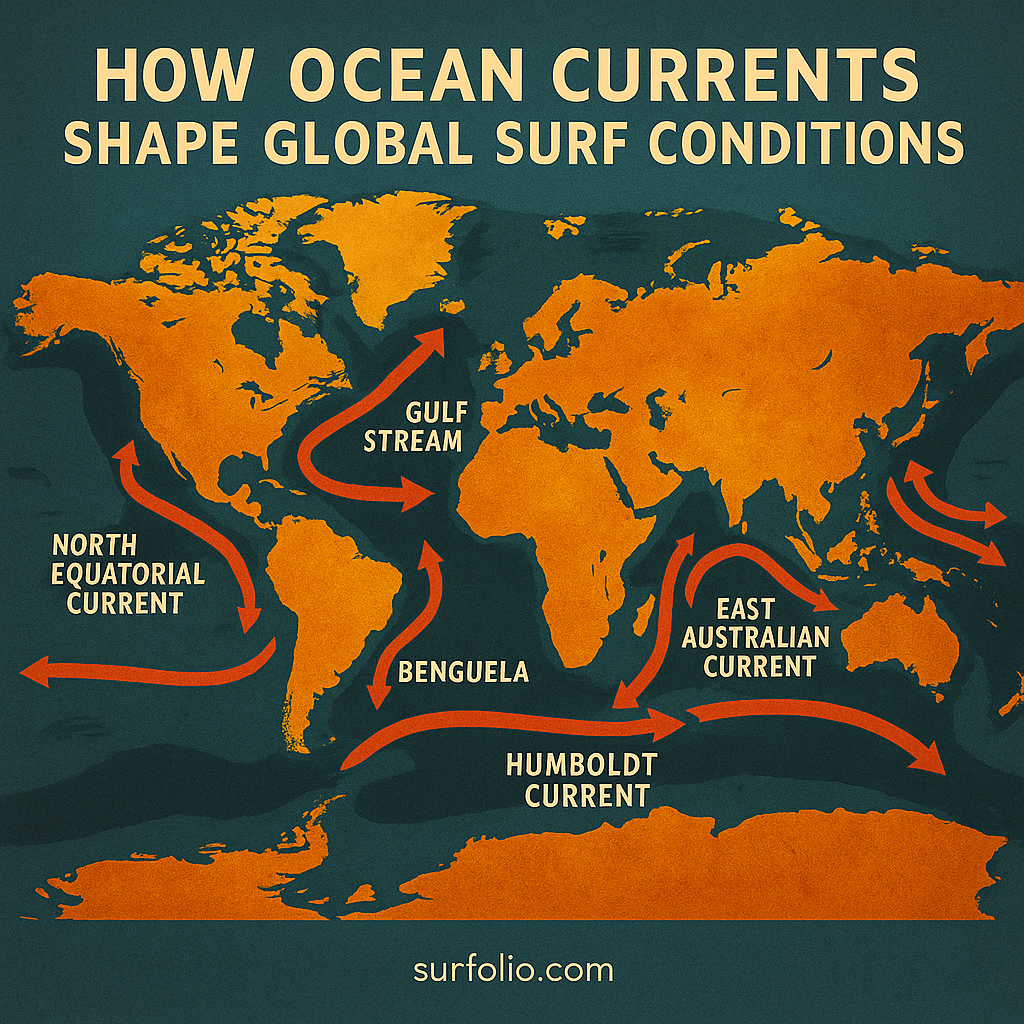
When surfers talk about “perfect conditions,” they often mention swell direction, wind speed, and tide—but behind all of that lies a much larger force: ocean currents. These invisible rivers of moving water circle our planet, distributing heat, shaping coastlines, and influencing where—and how—waves form.
Understanding how ocean currents work gives surfers a deeper awareness of why some regions produce consistent, powerful surf while others remain calm.
What Are Ocean Currents?
Ocean currents are continuous movements of seawater driven by wind, temperature differences, salinity, and the rotation of the Earth. They can be surface currents (affecting the upper 400 meters of the ocean) or deep-water currents that flow thousands of meters below.
Together, these systems create the global conveyor belt—a circulation pattern that helps regulate Earth’s climate and ocean temperatures. For surfers, currents matter because they directly affect swell generation, water temperature, and wave consistency at different locations.
How Ocean Currents Influence Surf Conditions
1. They Regulate Water Temperature
Warm and cold currents play a major role in determining local surf conditions:
- Warm currents, like the Gulf Stream off the U.S. East Coast or the Kuroshio Current near Japan, keep the surrounding waters mild, allowing for longer surf seasons.
- Cold currents, such as the California Current or the Humboldt Current in South America, lower water temperatures but often create cleaner, more powerful waves due to increased air density and offshore winds.
Temperature shifts can also influence wetsuit choice, wave power, and surf tourism seasons.
2. They Impact Swell Generation
Currents influence how storms develop and how swells travel across the ocean. For example:
- The South Equatorial Current funnels consistent swell energy toward Indonesia, creating world-class waves like Uluwatu and Padang Padang.
- In contrast, regions with opposing currents can cause swells to lose energy before reaching the shore, resulting in smaller or less consistent surf.
Where warm and cold currents collide—like off South Africa’s Cape of Good Hope—the resulting atmospheric instability often produces massive, high-energy swells that define iconic breaks.
3. They Affect Water Clarity and Density
Currents also determine how clear and buoyant the water feels under your board.
- Cold, nutrient-rich currents (like the Benguela and Humboldt) bring life to coastal ecosystems but make water denser and heavier—creating more push beneath your board.
- Warm tropical currents tend to carry lighter water, resulting in a smoother, more fluid feel during rides.
These subtle changes in density can affect paddling speed, takeoff timing, and even the way your board performs on a wave.
4. They Shape Regional Surf Consistency
Some surf regions owe their reliability to ocean current patterns. For example:
- California’s surf consistency is fueled by the cold California Current and Pacific storm systems that generate long-period swells.
- Western Europe, especially Portugal and France, benefits from the North Atlantic Drift, which channels energy from faraway Atlantic storms.
- Australia’s Gold Coast is fed by warm East Australian Current waters, which help stabilize local weather and enhance wave regularity during key seasons.
Understanding these interactions helps surfers plan where and when to chase waves—whether you’re after long, gentle rides or heavy reef barrels.
Major Global Currents and Their Surfing Impact
The Gulf Stream (Atlantic Ocean):
Keeps the U.S. East Coast warmer and occasionally fuels hurricane-generated surf from late summer through fall.
The California Current (Pacific Ocean):
Cold, nutrient-rich flow that cools the U.S. West Coast and helps produce clean, powerful waves—especially in Southern and Central California.
The Humboldt Current (South America):
One of the most influential for South American surf; its upwelling creates consistent offshore winds and cool water temperatures in Chile and Peru.
The Kuroshio Current (North Pacific):
Brings warm water north from the Philippines to Japan, extending the surf season and stabilizing tropical swell generation.
The East Australian Current:
The same current featured in Finding Nemo—it warms the Australian east coast and supports consistent surf from Byron Bay to Sydney.
How Surfers Can Use This Knowledge
- Plan Your Surf Trips Wisely: Knowing which current dominates a region helps predict the best times of year for consistent surf.
- Understand Local Climate Shifts: Currents affect water temps and wind patterns—key factors in local surf forecasting.
- Adapt Your Gear: Currents influence water temperature and salinity, so plan wetsuit thickness and board wax accordingly.
- Respect the Ocean System: The same currents that deliver waves also support marine ecosystems—stay conscious of pollution and plastic use.
The Bigger Picture
Ocean currents are nature’s unseen architects of surfing. They sculpt coastlines, transport swells, and keep the delicate balance that makes wave riding possible. For surfers, understanding them isn’t just about science—it’s about appreciation.
The next time you paddle out, think about the journey your wave took—perhaps born from a storm thousands of miles away, guided across the ocean by the steady pulse of Earth’s currents, finally arriving beneath your board.
That’s the beauty of surfing: every ride is part of a global rhythm.
